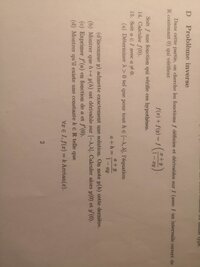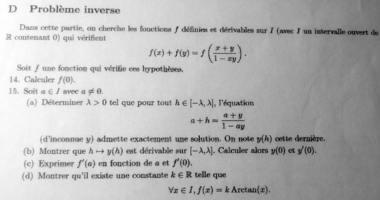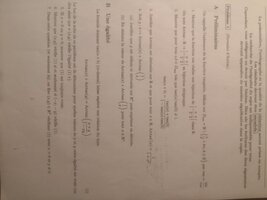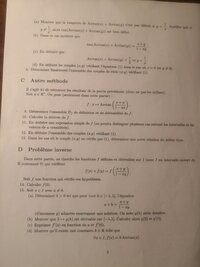Hi, idk how to solve 15.(a), if you can help me, thanks a lot.
Statement : In this part, we look for functions f defined and derivable on I (with I an open interval of R containing 0) that verify: f(x) + f(y) = f((x+y)/(1-xy))
Let f be a function that satisfies these hypotheses.
14.calculate f(0) (I found f(0)=0)
15. let, a∈I with a≠0
determine λ>0 as for all h∈[-λ;λ], the equation
a+h = (a+y)/(1-ay), (of unknown y) admits exactly one solution. This solution is denoted y(h). Then show that h->y(h) is derivable on [-λ;λ]. Calculate y(0) and y'(0)
I have several leads but nothing comes to fruition.
I first thought about solving this equation :
(a+h)(1-ay)=(a+y) which brought me back to a 2nd-degree equation, but I don't think that was very helpful (or idk how to deal with it)
Then, as the lim of (a+y)/(1-ay) is -1/a
So I thought it was sufficient to choose lambda small enough so that \[a - lambda, a + lambda] does not contain -1/a. But what lambda?
Or I thought as [-λ;λ] is '' symmetrical '' it contains 0 so we can choose h=0 but with this method I can't conclude about the possible value of lambda...
I'm stuck here, so if someone could help me out
(the goal of the problem is to find the arctan function so lambda should be equal to pi/2??)
Thanks
Statement : In this part, we look for functions f defined and derivable on I (with I an open interval of R containing 0) that verify: f(x) + f(y) = f((x+y)/(1-xy))
Let f be a function that satisfies these hypotheses.
14.calculate f(0) (I found f(0)=0)
15. let, a∈I with a≠0
determine λ>0 as for all h∈[-λ;λ], the equation
a+h = (a+y)/(1-ay), (of unknown y) admits exactly one solution. This solution is denoted y(h). Then show that h->y(h) is derivable on [-λ;λ]. Calculate y(0) and y'(0)
I have several leads but nothing comes to fruition.
I first thought about solving this equation :
(a+h)(1-ay)=(a+y) which brought me back to a 2nd-degree equation, but I don't think that was very helpful (or idk how to deal with it)
Then, as the lim of (a+y)/(1-ay) is -1/a
So I thought it was sufficient to choose lambda small enough so that \[a - lambda, a + lambda] does not contain -1/a. But what lambda?
Or I thought as [-λ;λ] is '' symmetrical '' it contains 0 so we can choose h=0 but with this method I can't conclude about the possible value of lambda...
I'm stuck here, so if someone could help me out
(the goal of the problem is to find the arctan function so lambda should be equal to pi/2??)
Thanks




